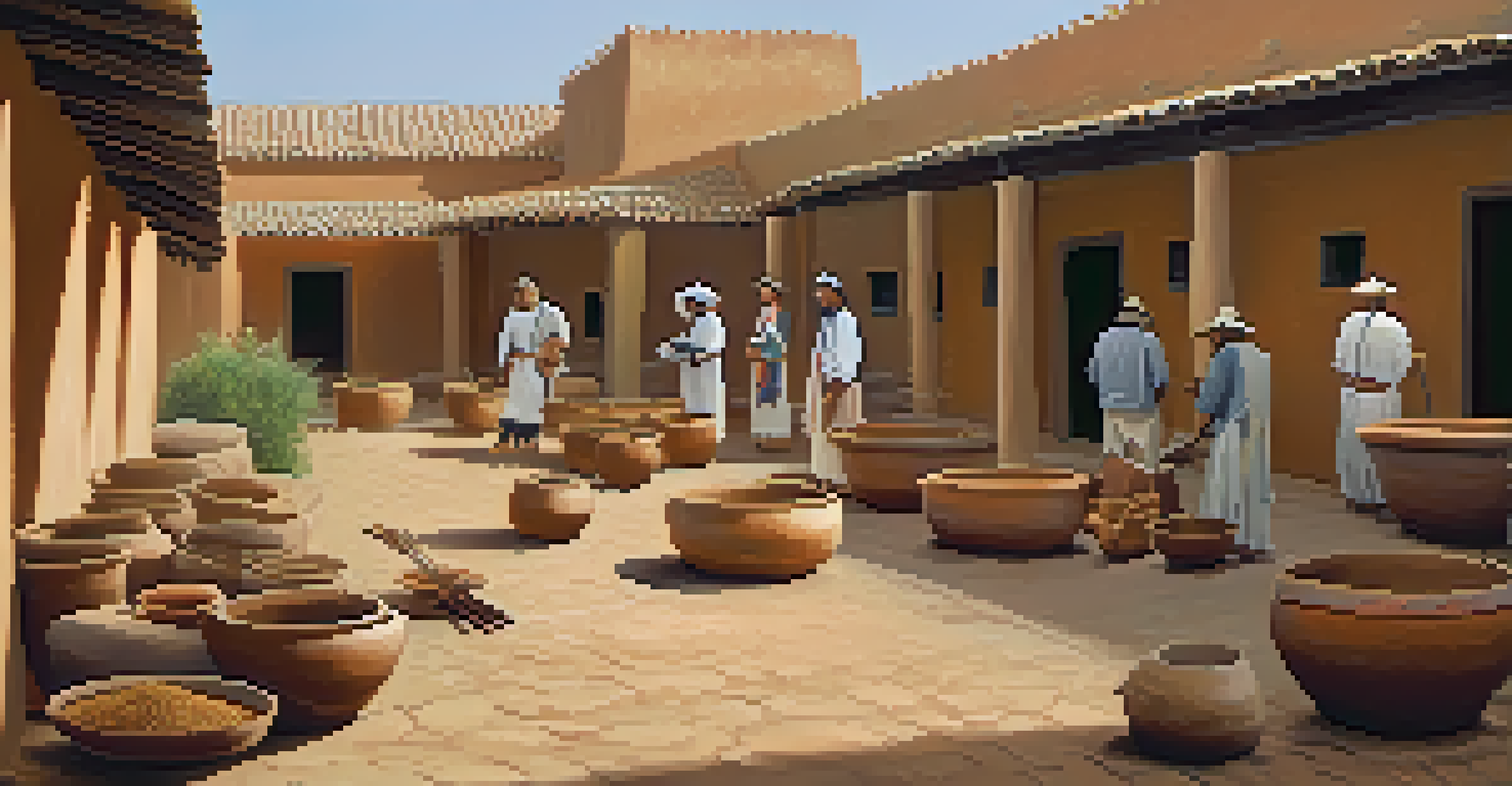Exploring the Mission System: A Model for Spanish Colonization

Understanding the Mission System: An Overview
The mission system was a crucial strategy used by the Spanish during their colonization efforts, particularly in the Americas. It aimed to convert Indigenous peoples to Christianity while also establishing Spanish culture and governance. This system laid the groundwork for not only religious conversion but also for the economic and social frameworks in newly colonized regions.
The mission system was a powerful tool for both cultural exchange and cultural suppression, reflecting the complexities of Spanish colonization.
At its core, the mission system involved the establishment of missions, which were religious outposts often situated in strategic locations. These missions served as centers for spiritual education, agricultural development, and community building. By combining religious and economic objectives, the Spanish sought to create self-sustaining settlements that would thrive under their governance.
The mission system was not just about faith; it represented a blend of cultural exchange and sometimes conflict. While many Indigenous people converted willingly, others resisted, leading to a complex dynamic of cooperation and resistance that characterized the colonization process.
The Role of Missions in Spanish Colonization
Missions played a vital role in the broader strategy of Spanish colonization, serving as both religious and military outposts. By establishing missions, the Spanish could extend their territorial claims while simultaneously spreading Christianity. This dual purpose made missions essential for maintaining control over vast, often remote areas of land.

The presence of missions also facilitated trade and communication between Spanish settlers and Indigenous tribes. As missions became centers of agricultural production, they contributed to the economic stability of the region, further integrating Indigenous populations into the colonial economy. This economic aspect was crucial in sustaining the Spanish presence in the New World.
Mission System's Dual Purpose
The mission system aimed to convert Indigenous peoples to Christianity while establishing Spanish culture and governance.
However, the missions also exemplified the tensions inherent in colonization. While they aimed to uplift and educate Indigenous peoples, they often imposed foreign values and disrupted traditional ways of life. This led to significant cultural shifts, many of which were met with resistance from Indigenous communities.
Key Figures in the Mission System
Several influential figures emerged within the mission system, each contributing to its development and implementation. Missionaries, often driven by a genuine desire to spread their faith, played a crucial role in establishing the missions. Figures like Junípero Serra became synonymous with the California missions, embodying the complexities of faith and colonization.
Understanding the mission system's impact is crucial for acknowledging historical injustices and promoting healing.
These missionaries were not only spiritual leaders but also educators, farmers, and diplomats. They often learned local languages, which helped them communicate and build relationships with Indigenous peoples. This cultural immersion was essential for the effectiveness of their mission efforts, as it fostered a sense of trust and understanding.
However, the legacy of these figures is mixed. While they contributed to the spread of Christianity and education, their actions also led to the suppression of Indigenous cultures and traditions. This dual legacy continues to spark discussions about the impacts of colonization on native populations.
Daily Life in the Missions
Life in a mission was a blend of religious devotion and agricultural labor. Indigenous converts often worked on mission farms, cultivating crops that were essential for sustaining the community. This labor was critical not only for the mission's survival but also for teaching new agricultural practices to the Indigenous peoples.
Daily routines typically included prayers, communal meals, and work in the fields. The missionaries aimed to create a structured environment that mirrored European lifestyles, promoting a sense of discipline and order. While this structure provided stability, it also stripped away many Indigenous customs and practices, leading to cultural assimilation.
Cultural Impact on Indigenous Peoples
While the mission system introduced new agricultural practices, it often suppressed Indigenous identities and traditions.
Despite the challenges, some Indigenous people found opportunities within the mission system. They learned new skills, gained access to European goods, and sometimes benefited from improved agricultural techniques. However, the costs of these benefits often included the loss of cultural identity and autonomy.
Impact on Indigenous Communities
The mission system had profound effects on Indigenous communities, both positive and negative. On one hand, it introduced new agricultural practices and technologies that improved food production. Many Indigenous people adapted these techniques, which sometimes led to increased food security and trade opportunities.
On the other hand, the imposition of Spanish culture and religion often came at a significant cost. Indigenous identities were challenged as traditional practices were suppressed. The pressure to conform to European customs created tensions within communities, leading to resistance and conflict in some areas.
The legacy of the mission system continues to be felt today. Many Indigenous peoples grapple with the effects of colonization, seeking to reclaim and revitalize their cultural heritage. Understanding the mission system's impact is crucial for acknowledging historical injustices and promoting healing.
The Decline of the Mission System
The decline of the mission system began in the late 18th and early 19th centuries, influenced by various factors including changing political landscapes and secularization. As Mexico gained independence from Spain, the missions lost their political and financial support, leading to their decline. Many missions were secularized, and their lands were redistributed, which disrupted the communities that had developed around them.
Additionally, the rise of new economic systems and the expansion of settlers into mission territories further eroded the mission's influence. As settlers sought land for farming and ranching, they often disregarded the rights of Indigenous peoples, leading to further displacement and conflict. This transition marked a significant shift from the mission-based model of governance to more direct colonial control.
Decline and Legacy of Missions
The decline of the mission system marked a significant shift in governance and led to the deterioration of many mission communities.
The decline of the mission system also led to the deterioration of many mission buildings and communities. While some missions were preserved and became historical sites, many others fell into disrepair. This loss signifies not only the fading of a colonial institution but also the erasure of Indigenous histories associated with these missions.
Legacy of the Mission System Today
Today, the legacy of the mission system is a topic of reflection and debate. Many mission sites have been preserved as historical landmarks, offering insight into this complex chapter of colonization. These sites serve as reminders of the cultural exchanges that occurred, as well as the conflicts and challenges that Indigenous peoples faced.
The mission system also plays a role in discussions about cultural heritage and reconciliation. For many Indigenous communities, reclaiming their history and identity is an ongoing process. Understanding the mission system's impact helps inform contemporary efforts to address historical injustices and promote healing.

In educational settings, the mission system is often examined as part of broader narratives about colonization and its effects on Indigenous populations. By exploring this history, we can foster a deeper understanding of the past and its relevance to current social and cultural dynamics.